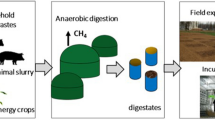Abstract
It is difficult to predict plant availability of N in faeces because most faecal N is bound in organic form. In this study the influence of diet and faeces composition on mineralization of sheep faeces in soil were investigated. Net mineralization of C and N from 16 different samples of sheep faeces originating from sheep fed different known diets was studied after incubation in a sandy soil. After 4 weeks net mineralization of N ranged from −41 to 9% of faeces N and after 12 weeks −28 to 43% was net mineralized. Mineralization was related to different feed and faeces characteristics (apparent digestibility, NDF, ADF, crude fibre, lignin, C/N ratio and N concentration) by regression analysis. The two single factors showing the highest correlation with N mineralization after 12 weeks were the log transformed N concentration of faeces and the C/N ratio (r=0.84 and r=−0.87). The N concentration and C/N of faeces were closely related to apparent digestibility of the feed (r=0.88 and r=−0.93), and apparent digestibility was the feed characteristic showing the highest correlation with faeces N mineralization after 12 weeks (r=0.81). The estimate of faeces N mineralization was not improved when chemical characteristics of the feed were combined in a multiple linear regression analysis. Mineralization of sheep faeces C showed the highest correlation with NDF of the feed (r=−0.89) and N concentration of faeces (r=0.88). The study showed that it is difficult to make reliable predictions of the mineralization of sheep faeces N in soil based on chemical analyses of the feed. However, when using a biological measure of the feed quality (apparent digestibility) a robust prediction of faeces N mineralization was possible.
Similar content being viewed by others
References
Andersen PE & Just A (1983) Tabeller over foderstoffers sammensæ tning m.m., 8th edn. Landhusholdningsselskabets Forlag, Copenhagen
Barrow NJ (1961) Mineralization of nitrogen and sulphur from sheep faeces. Austr J Agric Res 12: 644–650
Castellanos JZ & Pratt PF (1981) Mineralization of manure nitrogen– correlation with laboratory indexes. Soil Sci Soc Am J 45: 354–357
Floate MJS (1970) Decomposition of organic materials from hill soils and pastures. II. Comparative studies on the mineralization of carbon, nitrogen and phosphorus from plant materials and sheep faeces. Soil Biol Biochem 2: 173–185
Herman WA, McGill WB & Dormaar JF (1977) Effects of initial chemical composition on decomposition of roots of three grass species. Can J Soil Sci 57: 205–215
Hvelplund T & Madsen J (1990) A study of the quantitative nitrogen metabolism in the gastro-intestinal tract, and the resultant new protein evaluation system for ruminants. The AAT-PBV system. Royal Veterinary and Agricultural University, Copenhagen, Denmark
Jensen ES (1991) Evaluation of automated analysis of 15N and total N in plant material and soil. Plant Soil 133: 83–92
Kirchmann H (1991) Carbon and nitrogen mineralization of fresh, aerobic and anaerobic animal manures during incubation with soil. Swe. J Agric Res 21: 165–173
Mason VC (1969) Some observations of the distribution and origin of nitrogen in sheep faeces. J Agric Sci Camb 73: 99–111
Mø ller E, Andersen PE & Witt N (1989) En sammenligning af in vitro oplø selighed og in vivo fordø jelighed af organisk stof i grovfoder, 13. beretning fra Fæ llesudvalget for Statens Planteavls-og Hysdyrbrugsforsø g, Lyngby, Denmark
SAS (1989) Users Guide, Version 6, vol. 2, 4th edn, SAS Institute, Cary, NC
Sø rensen P & Jensen ES (1998) The use of 15N labelling to study the turnover and utilization of ruminant manure N Biol Fertil Soils 28: 56–63
Sø rensen P, Jensen ES & Nielsen NE (1994a) Labelling of animal manure with 15N. Plant Soil 162: 31–37
Sø rensen P, Jensen ES & Nielsen NE (1994b) The fate of 15Nlabelled organic nitrogen in sheep manure applied to soils of different texture under field conditions. Plant Soil 162: 39–47
Tecator (1978) Determination of crude fibre in some feed and food samples by using the fibertec and Weende method. Application note 01. Tecator AB, Sweden
Technicon (1974) Technicon autoanalyzer II method No 345-74 W. Ammonia in water and waste water, Technicon Industrial Systems, Tarrytown, NY
Van Soest PJ (1963) Use of detergents in the analysis of fibrous feeds. J. Assoc. Anal Chem 46: 825–835
Van Soest PJ (1994) Nutritional Ecology of the Ruminant, 2nd edn. Comstock Publishing Associates, New York
Van Veen JA & Kuikman PJ (1990) Soil structural aspects of decomposition of organic matter by micro-organisms. Biogeochemistry 11: 213–234
Vigil MF & Kissel DE (1991) Equations for estimating the amount of nitrogen mineralized from crop residues. Soil Sci Soc Am J 55: 757–751
Author information
Authors and Affiliations
Rights and permissions
About this article
Cite this article
Kyvsgaard, P., Sørensen, P., Møller, E. et al. Nitrogen mineralization from sheep faeces can be predicted from the apparent digestibility of the feed. Nutrient Cycling in Agroecosystems 57, 207–214 (2000). https://doi.org/10.1023/A:1009874500769
Issue Date:
DOI: https://doi.org/10.1023/A:1009874500769




